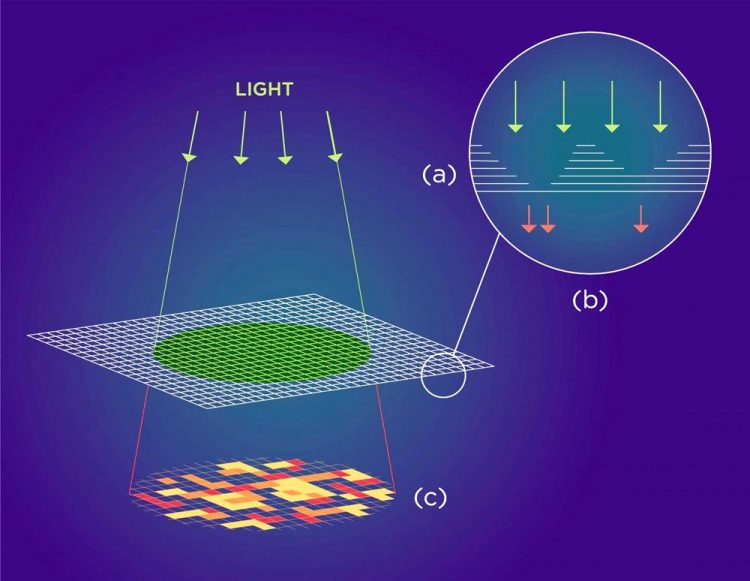The ultimate defense against hackers may be just a few atoms thick

a) At monolayer thickness, this material has the optical properties of a semiconductor that emits light. At multilayer, the properties change and the material doesn't emit light. (b) Varying the thickness of each layer results in a thin film speckled with randomly occurring regions that alternately emit or block light. (c) Upon exposure to light, this pattern can be translated into a one-of-a-kind authentication key that could secure hardware components at minimal cost. Credit: NYU Tandon: Althea Labre
The next generation of electronic hardware security may be at hand as researchers at New York University Tandon School of Engineering introduce a new class of unclonable cybersecurity security primitives made of a low-cost nanomaterial with the highest possible level of structural randomness. Randomness is highly desirable for constructing the security primitives that encrypt and thereby secure computer hardware and data physically, rather than by programming.
In a paper published in the journal ACS Nano, Assistant Professor of Electrical and Computer Engineering Davood Shahrjerdi and his NYU Tandon team offer the first proof of complete spatial randomness in atomically thin molybdenum disulfide (MoS2). The researchers grew the nanomaterial in layers, each roughly one million times thinner than a human hair. By varying the thickness of each layer, Shahrjerdi explained, they tuned the size and type of energy band structure, which in turn affects the properties of the material.
“At monolayer thickness, this material has the optical properties of a semiconductor that emits light, but at multilayer, the properties change, and the material no longer emits light. This property is unique to this material,” he said. By tuning the material growth process, the resulting thin film is speckled with randomly occurring regions that alternately emit or do not emit light. When exposed to light, this pattern translates into a one-of-a-kind authentication key that could secure hardware components at minimal cost.
Shahrjerdi said his team was pondering potential applications for what he described as the beautiful random light patterns of MoS2 when he realized it would be highly valuable as a cryptographic primitive.
This represents the first physically unclonable security primitive created using this nanomaterial. Typically embedded in integrated circuits, physically unclonable security primitives protect or authenticate hardware or digital information. They interact with a stimulus — in this case, light — to produce a unique response that can serve as a cryptographic key or means of authentication.
The research team envisions a future in which similar nanomaterial-based security primitives can be inexpensively produced at scale and applied to a chip or other hardware component, much like a postage stamp to a letter. “No metal contacts are required, and production could take place independently of the chip fabrication process,” Shahrjerdi said. “It's maximum security with minimal investment.”
###
The paper, “Physically Unclonable Cryptographic Primitives by Chemical Vapor Deposition of Layered MoS2” appears in the journal ACS Nano at http://pubs.
Co-authors include NYU Tandon doctoral candidate Abdullah Alharbi and graduate students Darren Armstrong and Somayah Alharbi. The National Science Foundation and the U.S. Army Research Office supported the research.
About the New York University Tandon School of Engineering
The NYU Tandon School of Engineering dates to 1854, the founding date for both the New York University School of Civil Engineering and Architecture and the Brooklyn Collegiate and Polytechnic Institute (widely known as Brooklyn Poly). A January 2014 merger created a comprehensive school of education and research in engineering and applied sciences, rooted in a tradition of invention and entrepreneurship and dedicated to furthering technology in service to society. In addition to its main location in Brooklyn, NYU Tandon collaborates with other schools within NYU, the country's largest private research university, and is closely connected to engineering programs at NYU Abu Dhabi and NYU Shanghai. It operates Future Labs focused on start-up businesses in downtown Manhattan and Brooklyn and an award-winning online graduate program. For more information, visit http://engineering.
Media Contact
All latest news from the category: Information Technology
Here you can find a summary of innovations in the fields of information and data processing and up-to-date developments on IT equipment and hardware.
This area covers topics such as IT services, IT architectures, IT management and telecommunications.
Newest articles

Security vulnerability in browser interface
… allows computer access via graphics card. Researchers at Graz University of Technology were successful with three different side-channel attacks on graphics cards via the WebGPU browser interface. The attacks…

A closer look at mechanochemistry
Ferdi Schüth and his team at the Max Planck Institut für Kohlenforschung in Mülheim/Germany have been studying the phenomena of mechanochemistry for several years. But what actually happens at the…

Severe Vulnerabilities Discovered in Software to Protect Internet Routing
A research team from the National Research Center for Applied Cybersecurity ATHENE led by Prof. Dr. Haya Schulmann has uncovered 18 vulnerabilities in crucial software components of Resource Public Key…





















